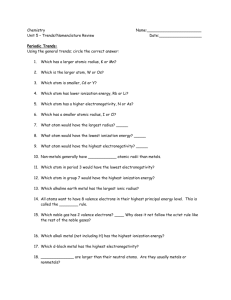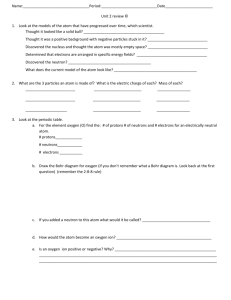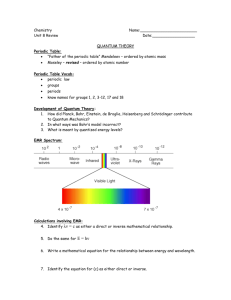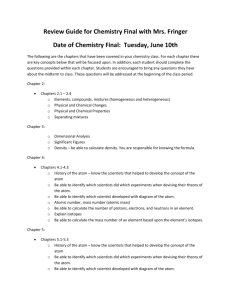Chemistry 1st semester final exam review Mr. Carr Topics Covered
advertisement
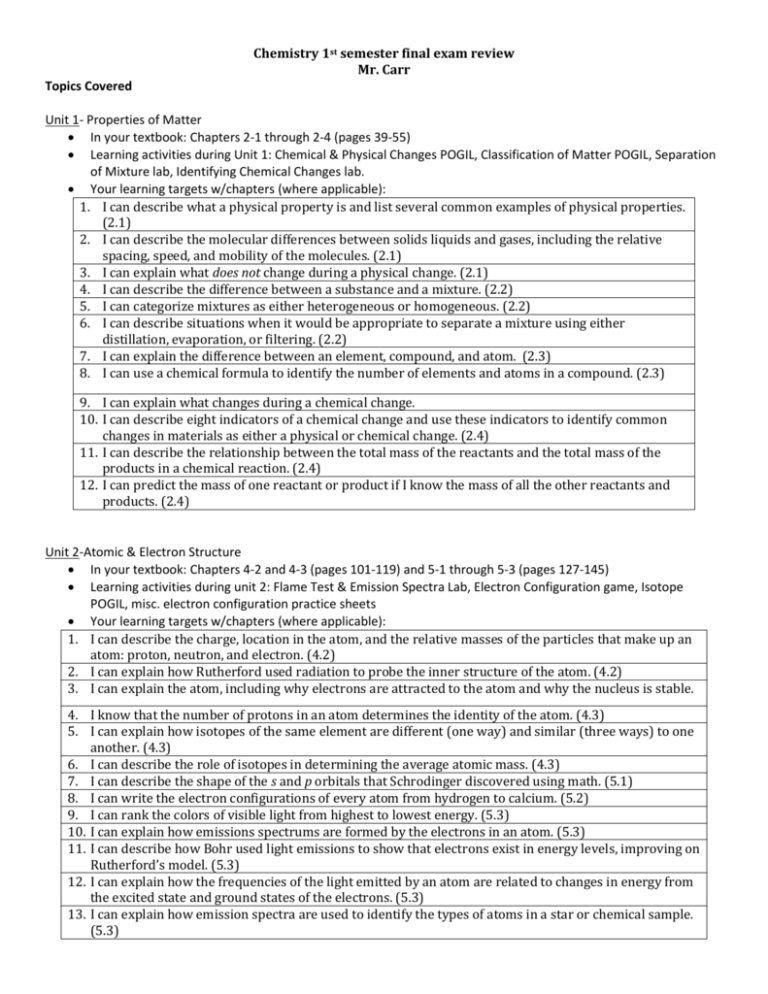
Chemistry 1st semester final exam review Mr. Carr Topics Covered Unit 1- Properties of Matter In your textbook: Chapters 2-1 through 2-4 (pages 39-55) Learning activities during Unit 1: Chemical & Physical Changes POGIL, Classification of Matter POGIL, Separation of Mixture lab, Identifying Chemical Changes lab. Your learning targets w/chapters (where applicable): 1. I can describe what a physical property is and list several common examples of physical properties. (2.1) 2. I can describe the molecular differences between solids liquids and gases, including the relative spacing, speed, and mobility of the molecules. (2.1) 3. I can explain what does not change during a physical change. (2.1) 4. I can describe the difference between a substance and a mixture. (2.2) 5. I can categorize mixtures as either heterogeneous or homogeneous. (2.2) 6. I can describe situations when it would be appropriate to separate a mixture using either distillation, evaporation, or filtering. (2.2) 7. I can explain the difference between an element, compound, and atom. (2.3) 8. I can use a chemical formula to identify the number of elements and atoms in a compound. (2.3) 9. I can explain what changes during a chemical change. 10. I can describe eight indicators of a chemical change and use these indicators to identify common changes in materials as either a physical or chemical change. (2.4) 11. I can describe the relationship between the total mass of the reactants and the total mass of the products in a chemical reaction. (2.4) 12. I can predict the mass of one reactant or product if I know the mass of all the other reactants and products. (2.4) Unit 2-Atomic & Electron Structure In your textbook: Chapters 4-2 and 4-3 (pages 101-119) and 5-1 through 5-3 (pages 127-145) Learning activities during unit 2: Flame Test & Emission Spectra Lab, Electron Configuration game, Isotope POGIL, misc. electron configuration practice sheets Your learning targets w/chapters (where applicable): 1. I can describe the charge, location in the atom, and the relative masses of the particles that make up an atom: proton, neutron, and electron. (4.2) 2. I can explain how Rutherford used radiation to probe the inner structure of the atom. (4.2) 3. I can explain the atom, including why electrons are attracted to the atom and why the nucleus is stable. 4. I know that the number of protons in an atom determines the identity of the atom. (4.3) 5. I can explain how isotopes of the same element are different (one way) and similar (three ways) to one another. (4.3) 6. I can describe the role of isotopes in determining the average atomic mass. (4.3) 7. I can describe the shape of the s and p orbitals that Schrodinger discovered using math. (5.1) 8. I can write the electron configurations of every atom from hydrogen to calcium. (5.2) 9. I can rank the colors of visible light from highest to lowest energy. (5.3) 10. I can explain how emissions spectrums are formed by the electrons in an atom. (5.3) 11. I can describe how Bohr used light emissions to show that electrons exist in energy levels, improving on Rutherford’s model. (5.3) 12. I can explain how the frequencies of the light emitted by an atom are related to changes in energy from the excited state and ground states of the electrons. (5.3) 13. I can explain how emission spectra are used to identify the types of atoms in a star or chemical sample. (5.3) Unit 3- Periodic Table In your textbook: Chapters 6-1 through 6-3 (pages 155-178) Learning activities during this unit: Coloumbic Attraction POGIL, Periodic Trends POGIL, Reactivity of Group I metals lab, Reactivity of Group II metals lab, and Reactivity of Non-metals lab, Atomic Size & Attraction and Trends on the Periodic Table worksheets. Your learning targets w/chapters (where applicable): 1. I can use the periodic table to identify each element as a metal, non-metal, or metalloid. (6.1) 2. I can describe key characteristics that distinguish metals from non-metals. (6.1) 3. I can describe how the periodic table is organized according to electron configuration including, groups (families), periods, and orbital blocks (s,p,d,f). (6.2) 4. I can use electron configurations to explain why elements in the same group (family) react in similar ways. (6.2) 5. I can describe the trend in electronegativity down a group. (6.3) 6. I can explain the trend in a group’s electronegativity using the relative distance of electrons from the nucleus. (6.3) 7. I can describe the trend in electronegativity across a period. (6.3) 8. I can explain the trend in a period’s electronegativity using the relative distance of electrons from the nucleus and the number of protons. (6.3) 9. I can explain the relationship between electronegativity and reactivity non-metals. (6.3) 10. I can explain the relationship between electronegativity and reactivity for metals. (6.3) Unit 4- Ionic Bonding & Naming In your textbook: Chapters 7-1, 7.2 (pages 187-198), 9.1, and 9.2 (253-266) Learning activities during unit 4: Formula of Aluminum Hydroxide lab, Formula of an Ionic Compound (Copper Phosphate) lab, Naming Practice Worksheets Your learning targets w/chapters (where applicable): 1. I can explain why valence electrons are important (7.1). 2. I can determine the number of valence electrons in elements in groups 1a-8a (7.1). 3. I can use the octet rule and Periodic Table to predict whether an atom will gain or lose electrons and how many electrons it will gain or lose (7.1). 4. I can predict how many electrons an atom will gain or lose based on its oxidation number. 5. I can determine the ratio of ions in an ionic compound based on how many electrons each atom gains or lose (9.5). 6. I can draw the Lewis Dot Structure for ionic compounds. 7. I can describe an ionic bond, and describe how cations and anions are formed (7.1). 8. I can state the types of elements that form ionic bonds (7.2). 9. I can explain how the ions that make up an ionic compound are held together (7.2). 10. I can explain what happens to an ionic compound when it dissolves in water and why some don’t dissolve in water(7.2). 11. I can explain why non-metals have only one oxidation number when they react with metals. 12. I can explain why metals with one oxidation number can only form one compound when they react with nonmetals (9.1, 9.2). 13. I can name and write the formula of compounds that contain metals with a single oxidation number bound to non-metals or polyatomic ions (9.1, 9.2). 14. I can explain why metals with multiple oxidation numbers can form multiple compounds when they react with a non-metal (9.1, 9.2). 15. I can name and write the formula of compounds that contain metals with multiple oxidation numbers bound to non-metals or polyatomic ions (9.1, 9.2). Unit 5- Ionic Bonding & Naming In your textbook: Chapters 2-1 through 2-4 (pages 39-55) Learning activities during unit 5: Covalent Bonds, Ionic Bonds, and Intermolecular Forces (a.k.a. The Slime) Lab, Naming Practice Worksheets Your learning targets w/chapters: 1. 2. 3. 4. 5. 6. 7. 8. I can explain what a covalent bond is and how it is different from an ionic bond. I can draw Lewis Dot Structures for simple molecules that contain single or double bonds. I can use electronegativity to explain why some molecules are polar and some are non-polar. I can describe hydrogen bonding and explain how it affects the strength of intermolecular forces. I can rank the relative strength of ionic bonds, covalent bonds, metallic bonds and intermolecular forces from weakest to strongest. I can explain how the strength of intermolecular forces affects the boiling points of covalent compounds. I can explain why ionic compounds tend to have higher melting and boiling points than covalent (molecular) compounds. I can name and write the formula for simple molecules (non-metals bound to non-metals). How & what to study How you study is up to you. Each person learns differently, but the important thing is to put in some time (a minimum of 3 to 4 hours between now and next Tuesday) reviewing what we’ve covered in biology so far this year. Review the class activities & labs listed in the learning targets. If you’ve kept an organized lab journal, these should be easy to find. If not, look for them on my webpage under the homework link. The end of each chapter in your textbook contains a summary of key points and practice tests. USE THESE RESOURCES! Get together with classmates and quiz each other. As you study take notes on topics you don’t understand. Use your resources (textbook, lab journal, etc) or the internet. There is a HUGE amount of online information about the topics we’ve studied so far. I recommend bozemanscience.com. If that doesn’t help, ask me about it during our class review next week. In class review and practice exam on Monday (last half of class) and Tuesday next week.
